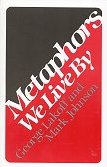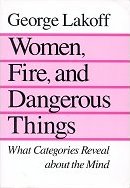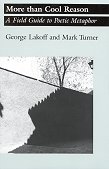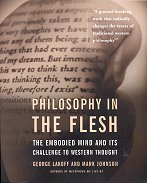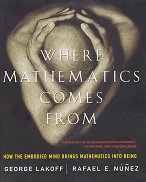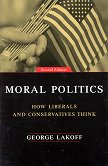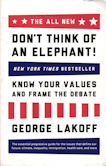It has taken me three months, off and on, to read this book. Not
because it is dull or boring, I hasten to add. Rather the opposite: it
was recasting fundamental concepts in my head, and I can take that
kind of action only so quickly.
The authors are interested in why mathematics is the way it
is, and why certain ideas are true. (This emphasis on
explanation, here and elsewhere,
is to be applauded; it contrasts well with the rather less helpful
"shut
up and calculate" schools of thought.) They explain that
structure of mathematics is built from various metaphors, ultimately
grounded in our embodied reality. As I understand it, the metaphors
are cognitive descriptions, that describe the way we embodied
creatures actually think and understand; the mathematics is a
construct that makes use of the metaphors (usually implicitly).
- First, there are grounding
metaphors --- metaphors that ground our understanding of
mathematical ideas in terms of everyday experience. ...
- Second, there are redefinitional
metaphors --- metaphors that impose a technical understanding
replacing ordinary concepts. ...
- Third, there are linking
metaphors --- metaphors within mathematics itself that allow
us to conceptualize one mathematical domain in terms of another
mathematical domain. ...
This is spellbinding stuff. The authors illustrate their thesis with
a host of deep and fascinating examples, teasing out the actual
metaphors that seem to underlie many parts of mathematics. These
metaphors are (for the most part) stunningly simple and utterly
compelling. They start with the four grounding metaphors of
arithmetic, then move on to a host of linking metaphors. Much of the
book is taken up with applications of the Basic Metaphor of Infinity
(BMI), showing how this single metaphor, when blended and combined
with others, can explain the approach to infinity taken in many
different branches of mathematics. They cover a wide range of
mathematical concepts, and illuminate every single one.
I found the discussion of the role of infinitesimals, the reason for
the differences between transfinite cardinals and ordinals, and the
case study of the "bumpy line" paradox, particularly fine.
(I did find the final big case study, of why exp iπ + 1 = 0,
just a bit of a let-down, possibly because I has come across most of
the explanations before, and the final explanation of just why exp iθ
= cos θ + i sin θ
felt a little bit of a cop-out. But these exceptionally clear
explanations given would make an excellent addition to a course
teaching this for the first time.)
The authors' argument that learning mathematics would be made
simpler by making these metaphors explicit sounds very plausible.
Their own explanations of usually difficult concepts are mostly
examples of remarkable clarity. (There are some problems, admittedly.
In particular, I found the explanation of sequence limits, involving
so-called critical elements, to be incomprehensible; I think
they are just wrong here.)
The authors claim that the existence of these metaphors disproves
the existence of objective mathematical reality (but they hasten to
add they are not advocating a postmodernist philosophy; embodiment
means there really are universal human aspects to mathematics,
if not transcendent, Platonic, ones). Whether or not you
believe the disproof, and my other quibbles notwithstanding, this is
well worth reading. Read it if you want to understand the metaphors
underlying mathematics, or even just to deepen your understanding of
(some) of the mathematics itself.
Minor observations:
I have a few niggles with some of the metaphors.
- The "object collection" metaphor entailment, used to
explain why n * 1/n = 1, can't be that concrete. We
all know if you cut something in half, then glue it back together
again, you don't get quite what you started with: there's
missing sawdust, and a joint.
- The four metaphors identified for innate arithmetic are "object
collection", "object construction", "measuring
stick," and "motion along a path". Notice that these
all give the same laws of arithmetic. The authors explain
this is because there are isomorphisms across the metaphors.
But why should there be these isomorphisms?
- "Multiplication by -1 is rotation". Certainly, once you
have complex numbers, and the complex plane, this is an appropriate
metaphor. But the authors' argument seems to be that the new complex
numbers fit into neatly into this existing metaphorical structure.
But it seems to me when all you have is the 1D real number line, a
more natural metaphor is "Multiplication by -1 is reflection"
-- which doesn't then extend naturally to the 2D complex plane. I
wonder if the rotation metaphor came later?
There is a rather nice distinction made amongst:
- The number (e.g.,
thirteen)
- The conceptual representation
of the number: the sum of products of powers adding up to that
number (e.g., one times ten to the first power plus three times
ten to the zeroth power)
- The numeral that symbolizes
the number by, in turn, symbolizing the sum of products of
powers (e.g., 13)
This is a useful distinction to make: our base ten (sum of products
of powers of ten) representation is so deeply ingrained it is
difficult even to notice it. But base ten is not the only conceptual
representation we have. We can choose a conceptual representation to
make a particular calculation easier. As well as the familiar base
ten, we could choose other bases (such two, eight and sixteen for
computer arithmetic, or 360 for angles); products of prime factors for
whole numbers; fractions or decimal expansions for rational numbers;
continued fractions for irrational numbers; etc. Similarly, complex
numbers can be represented as rectangular or polar coordinates. The "numerals"
that symbolise these other representations are often less familiar
than our base ten symbolisation, however.
The authors point out that the folk theory of essences, with
its categories and necessary and sufficient conditions, has has a deep
influence on (Western) mathematics:
the axiomatic
method is the manifestation in Western mathematics of the folk theory
of essences inherited from the Greeks.
and, possibly more problematically, on science:
it is not true
that the theory of essences, in either its folk or expert version,
fits the physical world. ... A species cannot be defined by necessary
and sufficient conditions ... Indeed, in biology, the folk theory of
essences has interfered with the practice of science.
This links in to the much more extensive discussion in Women,
Fire, and Dangerous Things about its influence on the way we
think we categorise things, in contrast to the way we actually
categorise things. It has implications for the current enthusiasm for
object-oriented modelling in
computer systems (which is why I started reading Lakoff in the first
place).
The Numbers are Points on a Line metaphor may be more grounded than
the authors assume. Ramachandran, in Phantoms
in the Brain, reports there is a line of neurons in the
brain that represent numbers.
The authors argue that Weierstrass continuity is not a
generalisation of natural continuity (as characterised by Euler),
because there are some monster curves that are not naturally
continuous, but are Weierstrass continuous, such as x sin(1/x)
at the origin. But there is an implicit infinity in this curve at the
origin, so maybe natural continuity as characterised by Euler first
needs to be extended with the BMI (Basic Metaphor of Infinity) to
capture the motion of a point at infinity, at which point the curve
is "naturally" continuous?
Other quotes:
Everything we
perceive or think of as an action or event is conceptualized as having
[aspect]
structure.
... that is, Readiness; Starting up; The main process; Possible
interruption and resumption; Iteration or continuing; Check purpose
achieved; Completion; Final state
it is no
accident that 1 is used for true and 0 for false and not the reverse.
It is
important to contrast our everyday concept of Same Number As with ...
Cantor's concept of pairability --- that is, capable of being put into
one-to-one correspondence. ... the ideas are different in a
significant way, but the happen to correlate precisely for finite
sets. The same is not true for infinite sets. ... This distinction has
never before been stated explicitly using the idea of conceptual
metaphor. ... [pairability]
is a metaphorical rather than a literal
extension of our everyday concept. The failure to teach the difference
between Cantor's technical metaphorical concept and out ordinary
concept confuses generation after generation of introductory students.
On the
formalist view of the axiomatic method, a "set" is any
mathematical structure that "satisfies" the axioms of set
theory ... Many writers speak of sets as "containing" their
members ... Even the choice of the word "member" suggests
such a reading, as do the Venn diagrams used to introduce the subject.
But if you look carefully through those axioms, you will find nothing
in them that characterizes a container. The terms "set" and "member
of" are both taken as undefined primitives. ... most of us do
conceptualise sets in terms of Containment schemas, and that is
perfectly consistent with the axioms ... However ... a constraint
follows automatically:Sets cannot be members of themselves ...
this constraint does not follow from the axioms ...
[So the axiom of Foundation]
was proposed [to]
rule out this possibility. ... our
ordinary grounding metaphor that Classes are Containers gets in the
way of modeling [recursive]
phenomena. ... Set theorists have
realized that a new noncontainer metaphor is is needed for thinking
about sets, and they have explicitly constructed one: hyperset theory
... The idea is to use graphs, not containers, for characterizing
sets.
Outside
mathematics, a process is seen as infinite if it continues (or
iterates) indefinitely without stopping. That is, it has imperfective
aspect (it continues indefinitely) without an endpoint. This is the
literal concept of infinity outside mathematics.
Processes are
commonly conceptualized as if they were static things --- often
containers, or paths of motion, or physical objects. ... We speak of
the parts of a process, as if it were an object with parts and with a
size. ... one of the most important cognitive mechanisms for linking
processes is ... "fictive motion", cases in which an
elongated path ... can be conceptualized metaphorically as a process
tracing the length of that path ... in mathematics, processes can be
conceptualized as atemporal. ... The [Fibonacci]
sequence can be conceptualized either as
an ongoing infinite process of producing ever more terms or as a
thing, an infinite sequence that is atemporal. This dual
conceptualization ... is part of everyday cognition.
On Hardy's warning not thinking of
 ,
infinity, as a number:
,
infinity, as a number:
when there are
explicit culturally sanctioned warnings not to do something, you can
be sure that people are doing it. Otherwise there would be no point to
the warnings. ... there are, cognitively, different uses for numbers
--- enumeration, comparison, and calculation. ... mathematicians have
devised notions ... in which  is a number with respect to enumeration, though not calculation. For
Hardy, an entity either was a number or it wasn't, since he believed
that numbers were objectively existing entities. The idea of a "number"
that had one of the function of a number (enumeration) but not other
functions (e.g., calculation) was an impossibility for him. But it is
not an impossibility from a cognitive perspective
is a number with respect to enumeration, though not calculation. For
Hardy, an entity either was a number or it wasn't, since he believed
that numbers were objectively existing entities. The idea of a "number"
that had one of the function of a number (enumeration) but not other
functions (e.g., calculation) was an impossibility for him. But it is
not an impossibility from a cognitive perspective
The BMI
[Basic Metaphor of Infinity]
... is often the conceptual equivalent
of some axiom that guarantees the existence of some kind of infinite
entity (e.g., a least upper bound). And just as axioms do, the special
cases of the BMI determines the right set of inference required.
an ordinary
natural number ... can have a cardinal use; that is, it can be
used to indicate how many elements there are in some collection. It
can also have an ordinal use; that it, it can be use to
indicate a position in a sequence. .... These are two very different
uses of numbers. ... the arithmetic of the natural numbers is the same
for cardinal and ordinal uses. But this is not true for transfinite
numbers. Cantor's metaphor determines "size" for an infinite
collection by pairing, not counting in a sequence. Cantor's metaphor,
therefore, is only about cardinality (i.e., "size") not
about ordinality (i.e., sequence). ... there are no transfinite
numbers that can have both cardinal and ordinal uses. Rather, two
different types of numbers are needed, each with its own properties
and its own arithmetic. ... You can get different results by "counting"
the members of a fixed collection in different orders! The reason for
this has to do with the different metaphors needed to extend the
concept of number to the transfinite domain for ordinal as opposed to
cardinal uses. ... Recall that "addition" for transfinite
cardinals is defined in terms of set union. ... it follows that ...
ℵ0+1=ℵ0
... But the situation is very different with ordinal numbers. ... we
can go on forming longer sequences by appending a further sequence "after"
the ω position. ... ω≠ω+1.
However, 1+ω=ω.
ignoring
certain differences is absolutely vital to mathematics! ... calculus
is defined by ignoring infinitely small differences.
Conceptually,
[Cantor's transfinites, and the hyperreals]
are two utterly different structures,
leading to two utterly different notions of "infinite numbers".
... How can there be two different conceptions of "infinite
number", both valid in mathematics? By the use of different
conceptual metaphors, of course
any technical
discipline develops metaphors that are not in the everyday conceptual
system. In order to teach mathematics, one must teach the difference
between everyday concepts and technical concepts, making clear the
metaphorical nature of the technical concepts.
Given the
metaphor A Space is a Set of Points, "points" are not
necessarily spatial in nature, but can be any kind of mathematical
entities at all. ... one must learn which kinds of mathematical
problems require which metaphors.
In modern
mathematics, the lack of a feature is conceptualized metaphorically as
the presence of that feature with value zero.
The rational
numbers, by themselves, have no gaps. In the set of rational
numbers, rational numbers are all there is. ... The "gap" is
in the space domain, where there are points on a naturally continuous
line that are not paired with rational numbers. This "gap"
makes sense only in the metaphorical conceptual blend that Dedekind
was constructing and we have inherited.
Of the "bumpy curve" paradox:
this
metaphorical image ignored the derivatives (the tangents) of the
functions, which are crucial to the question of length
[because the measuring rods lie along the
tangents]
the claim that
transcendent mathematics exists appears to be untenable. One important
reason is that mathematical entities such as numbers are characterized
in mathematics in ontologically inconsistent ways. ... since
transcendent mathematics takes each branch of mathematics to be
literally and objectively true, it inherently claims that it is
literally true of the number line that numbers are points, literally
true of set theory that numbers are sets, and literally true of
combinatorial game theory that numbers are values of positions. ...
But again, according to transcendent mathematics, there should be a
single kind of thing that numbers are; that is, there should be a
unique ontology of numbers.
... I can almost hear the mutters of "only up to an isomorphism",
though. What I find fascinating is that although these areas have
their own numbers, those numbers are all the "same" (obey
the same properties). This sameness is used by some as an argument of
their external objective existence, and by others as an argument of
their single origin, our own minds.
But the only
access that human beings have to any mathematics at all, either
transcendent or otherwise, is through concepts in our minds that are
shaped by our bodies and brains and realized physically in our neural
systems. For human beings --- or any other embodied beings ---
mathematics is embodied mathematics. The only mathematics we
can know is the mathematics that our bodies and brains allow us to
know. For this reason, the theory of embodied mathematics ...
[is] a
theory of the only mathematics we know or can know, it is a theory of
what mathematics is --- what it really is! ... But there are
excellent reasons why so many people, including professional
mathematicians, think that mathematics does have an independent,
objective, external existence. The properties of mathematics are, in
many ways, properties that one would expect from our folk theories of
external objects.
... but surely this is true of anything: "The only X
we can know is the X that our bodies and brains allow us to
know". Since the authors admit there are external
objects, why no external mathematical objects? I assume it is that
they admit the existence of objects, but not categories of
objects, and hence not of mathematical categories like number.
Nevertheless, I feel a residual Johnson-esque need to kick a stone
(one stone, two stones, ...) and mutter "I refute it thus".
a significant
part of mathematics itself is a product of historical moments,
peculiarities of history, culture, and economics. This is simply a
fact. In recognizing the facts for what they are, we are not
adopting a postmodernist philosophy that says mathematics is merely
a cultural artifact. We have gone to great lengths to argue
against such a view. ... In recognizing all the ways that mathematics
makes use of cognitive universals and universal aspects of experience,
the theory of embodied mathematics explicitly rejects any possible
claim that mathematics is arbitrarily shaped by history and culture
alone.
Even an idea
as apparently simple as equality involves considerable cognitive
complexity. From a cognitive perspective, there is no single meaning
of "=" that covers all these cases
["yields", "gives", "produces",
"can be decomposed into", "can be factored into", "results
in", ...].
The authors give away their ages:
Think for a
moment of how a slide rule works.
Why do e,
π, i, 1, and 0 come up all the time when we do mathematics, while most
numbers ... do not? The reason is that these numbers express common
and important concepts via arithmetization metaphors. Those concepts,
like recurrence, rotation, change and self-regulation are important in
our everyday life.
